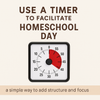
Mastering the Homeschool Day: How a Simple Timer Can Transform Your Routine
, by Gabrielle C, 3 min reading time

, by Gabrielle C, 3 min reading time
Why Timers Work Wonders for Multi-Level Homeschooling
When you’re homeschooling multiple grade levels at once, time can feel like it’s constantly slipping through your fingers. Between teaching phonics to a first grader, reviewing algebra with a middle schooler, and grading essays for your high schooler, the day can quickly spiral into chaos.
That’s where one of the most underrated homeschool tools comes in... the humble timer.
Keeps Everyone on Track
Kids (and adults!) thrive with clear expectations. A timer turns “work on your math” into “you have 20 minutes to finish your math assignment.” It gives each subject or task a defined start and end, which helps eliminate procrastination and wandering attention.
Balances Time Between Multiple Kids
If you’re bouncing between an 11-year-old’s reading lesson and a 15-year-old’s chemistry lab, it’s easy for one subject, or one child, to take over the day. Setting a timer ensures each child gets focused attention without shortchanging anyone else.
Fosters Independence
Older kids can manage their own work blocks using the timer, which frees you up to focus on younger learners. Over time, they learn self-discipline and time management skills that will benefit them for life.
Reduces Overwhelm
Some children feel stressed by a long assignment. Breaking the day into smaller, timed chunks makes big tasks feel doable. A 15-minute writing sprint is far less intimidating than “write an essay.”
Adds Fun and Motivation
For younger kids, a timer can turn learning into a game: “Let’s see if you can beat the clock and finish your spelling before the bell rings!” This playful approach can boost focus and energy.
Morning Start Cue – Signal that school is beginning with a 5-minute countdown.
Subject Rotation – Give each child a set time for one-on-one lessons before rotating to the next.
Break Reminders – Keep recess and snack breaks on schedule so the day doesn’t drift away.
Silent Reading Time – Set 15–20 minutes for focused reading without distractions.
Clean-Up Challenge – End the school day with a quick-timer race to tidy up books and supplies.
A good timer should be easy to set, highly visible, and durable enough for daily use. I’m thrilled to share that my store now carries a versatile homeschool-friendly timer that’s perfect for managing your day. It’s designed to be simple enough for kids to use, with a clear display and a loud-but-friendly alert that won’t startle anyone.
You can check out the timer I offer in OUR CATELOG!
Whether you’re wrangling preschoolers, high schoolers, or a mix of both, using a timer can bring structure, balance, and peace to your homeschool day — all without adding stress to your already busy schedule.
Sometimes the simplest tools really do make the biggest difference.